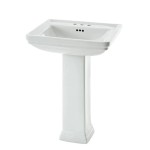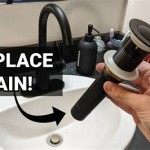How To Stop My Bathroom Drain From Smelling
A foul odor emanating from your bathroom drain can be a source of discomfort and embarrassment. This unpleasant scent is often caused by a buildup of bacteria, hair, soap scum, and other debris that decompose and release unpleasant gases. While the occasional whiff might be tolerable, a persistent bathroom drain odor indicates a problem that requires attention. Fortunately, there are several effective solutions to tackle this issue and restore the pleasant ambiance of your bathroom.
1. Understanding the Cause
Before attempting any solutions, it is crucial to understand the root cause of the odor. The most common culprit is a buildup of organic matter in the drain trap. The drain trap is a curved section of the drainpipe that holds a small amount of water, creating a seal that prevents sewer gases from entering your bathroom. If the trap dries out, these gases can escape, causing the unpleasant smell.
Other causes of bathroom drain odor include:
- Hair and soap scum buildup: These substances accumulate over time, creating a breeding ground for bacteria that release foul odors.
- Clogged drain: A clogged drain can trap water and create a stagnant environment where bacteria thrive and produce an unpleasant smell.
- Broken drain trap: A cracked or broken drain trap can allow sewer gases to escape into your bathroom.
- Dry P-trap: A dry P-trap is a common source of odor. The P-trap is the curved pipe under the sink that holds water to prevent sewer gases from coming into your bathroom. If that water evaporates, the sewer gases can escape.
2. DIY Solutions for Bathroom Drain Odor
Once you have identified the likely cause of your bathroom drain odor, you can implement effective DIY solutions to eliminate it. These methods are generally budget-friendly and can be performed with readily available materials.
2.1 Flushing the Drain with Hot Water
A simple yet effective solution is to flush the drain with hot water. The heat helps to loosen any accumulated debris and encourages it to flow down the drain. Pouring a kettle of boiling water down the drain multiple times can often clear out minor blockages and reduce odors. For a stronger cleaning action, add baking soda and vinegar to the hot water. The reaction creates a fizzing effect, effectively loosening and dislodging stubborn debris.
2.2 Using a Drain Cleaner
Commercial drain cleaners are readily available at grocery stores and hardware stores. These products contain powerful chemicals that can dissolve organic matter and remove blockages. However, it is important to use these cleaners with caution, as they can be corrosive and harmful if used incorrectly. Always follow the instructions on the product label carefully and ensure proper ventilation while using them.
2.3 Baking Soda and Vinegar
A natural alternative to commercial drain cleaners is a baking soda and vinegar solution. Pour a cup of baking soda down the drain, followed by a cup of white vinegar. The reaction between these ingredients creates a fizzing action that loosens and removes debris. Allow the mixture to sit for 30 minutes before flushing with hot water.
2.4 Using a Plunger
A plunger can effectively remove blockages that are causing the drain odor. Plunge the drain vigorously for several minutes, applying pressure to dislodge any stubborn debris. If the plunger does not work, try a different type of plunger, such as a cup plunger or a sink plunger.
2.5 Using a Drain Snake
A drain snake is a long, flexible tool with a hooked end that can be inserted into the drain to remove stubborn blockages. Insert the snake into the drain and rotate it to loosen and remove any accumulated hair, soap scum, or other debris. Always be careful when using a drain snake and avoid forcing it beyond its reach.
3. Preventive Measures for Bathroom Drain Odor
Once you have addressed the existing odor, taking preventive measures is crucial to prevent future occurrences.
3.1 Regular Drain Cleaning
Regularly cleaning your bathroom drain is essential to prevent the buildup of hair, soap scum, and other debris that can create a breeding ground for odor-causing bacteria. Pour a cup of baking soda down the drain followed by a cup of vinegar once a week. This simple routine helps to keep your drain clean and prevent odors from accumulating.
3.2 Hair Strainer
A hair strainer placed over the drain can effectively capture hair and other debris before they enter the drainpipe. This simple precaution can significantly reduce drain clogging and prevent the buildup of odor-producing substances.
3.3 Avoid Pouring Grease and Oils
Grease and oils can solidify in the drainpipe over time, contributing to clogging and odor. Avoid pouring grease and oils down the drain and dispose of them properly. Use a grease trap to collect grease from cooking and dispose of it in the trash.
3.4 Keep the Drain Trap Filled
The drain trap should always be filled with water. This acts as a barrier, preventing sewer gases from entering the bathroom. If the trap dries out, pour a cup of water down the drain to replenish it. By implementing these preventive measures, you can proactively maintain a fresh and odor-free bathroom drain.

How To Clean A Stinky Sink Drain Home Repair Tutor

Why Your Drain Smells And How To Fix It Fast

How To Get Rid Of The Sewer Smell From A Bathroom Terry S Plumbing
:max_bytes(150000):strip_icc()/__opt__aboutcom__coeus__resources__content_migration__mnn__images__2018__08__sink_drain-351af8e441034f319fe07f00c091d8b6.jpg?strip=all)
How To Clean A Smelly Drain Naturally

How Can I Help A Stinky Bathroom Sink Drain Cleaning More

How To Clean Stinky Drains Liquid Plumr
What Can I Pour Down My Bathroom Sink To Make It Smell Better Quora

What Causes Bathroom Drains To Smell

How To Clean Stinky Drains Liquid Plumr

Two Easy Ways To Fix A Smelly Shower Drain I Rick S Plumbing
Related Posts







